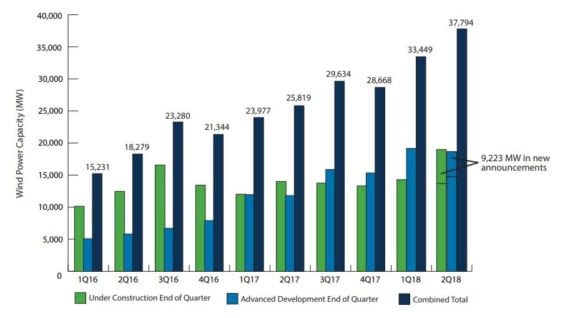The US President might have made a lot of friends by promising to bring back jobs for the coal industry, but it’s the country’s wind energy industry which is making the strongest headway, with new figures showing a record amount of wind energy capacity under construction and a pipeline in excess of 37GW.
The American Wind Energy Association (AWEA) published its US Wind Industry Second Quarter 2018 Market Reportlast week, highlighting the last quarter of wind development and construction across the country.
The second quarter saw a total of 626 MW worth of new capacity installed, pushing the amount installed so far this year up to 1,032 MW – relatively in line with the country’s quarterly installation figures over the last several years.
However, while US installation figures might seem a little lacklustre, it is the country’s cumulative strength and current pipeline which really draws the eye – especially when you contrast them with the current rhetoric of President Donald Trump and his love-affair with the coal industry.
The second quarter saw the US wind energy industry finally break the 90 GW barrier, and it now boasts 90,004 MW worth of wind energy installed across 41 states (plus Guam and Puerto Rico).
What’s even more impressive, however, is the current wind energy pipeline. According to the AWEA, the second quarter saw 5,322 MW worth of wind capacity begin construction, bringing the country’s total wind energy construction up to a record 18,987 MW.
When combined with projects entering advanced development, which hit 18,806 MW – including 3,901 MW added in the second quarter alone – the total pipeline of wind capacity development in the US reached an impressive 37,794 MW.
“Wind power’s job creating engine just kicked into a higher gear,” said Tom Kiernan, CEO of AWEA. “And all Americans will benefit as the record number of wind farms under construction begin delivering new revenue to rural communities and affordable homegrown energy to consumers.”
It’s worth noting that the US seems to have a perpetually large pipeline of wind projects under development that only grows with each quarter that passes. A year ago, the AWEA boasted a total pipeline of 25,819 MW but, since then, the industry only installed 5,691 MW while simultaneously increasing its pipeline by 11,975 MW.
Nevertheless, even if the US wind energy industry’s pipeline is not expected to come to full-fruition immediately, the continued and steady growth continues to speak volumes regarding where the power lays.
Regardless of President Trump’s repeated and hyperbolic promises to bring back jobs to the coal industry, and despite current attempts to literally bail out the coal (and nuclear) industry for providing some mythically-necessary baseload power requirements, large-scale renewables such as wind (and solar) continue to attract considerable interest and investment.
One need only look at recent figures published by the US Government’s own Energy Information Administration (EIA) to see that coal’s contribution to the US electricity mix continues to fall – dropping to 27% over the first third of 2018 – while renewables accounted for 22%, nudging out nuclear energy which only accounted for 19.5% over the same period.
All of which only solidifies what any neutral observer was already aware of – rhetoric and political bailouts won’t save fossil fuels in the face of such sustained renewable energy momentum.












